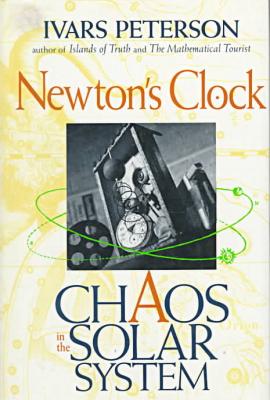

| NEWTON'S CLOCK: Chaos in the Solar System Ivars Peterson New York: W. H. Freeman & Company, 1993 |
Rating: 5.0 High |
|||
| ISBN 0-7167-2396-4 | 317pp. | HC/BWI | $22.95 | |
Peterson compares the growth of his own interest in astronomy during his childhood in Canada's Ontario province to the patient development of that oldest of sciences across the many centuries from Ptolemy to Pioneer. Along the way he provides the clearest account I've seen of the Titius-Bode Law (pp 17-19) and describes how mathematical descriptions of the solar system gradually evolved from Ptolemy's crystal spheres to our current understanding that the solar system is, in both popular and precise meanings of the term, chaotic.
Chapter Two opens with the discovery and analysis of the Antikythera Mechanism, a complicated bronze device found by Greek sponge divers in 1900 and dated to 87 B.C. This intricate artifact appears to have been made by a craftsman in the school of Posidonios, a prominent astronomer on the island of Rhodes. It is "an elegant simulation of the heavens" — the earliest known simulation of the motions of celestial bodies. Another highlight of Chapter Two is the tale of how a book of tables compiled by a German astronomer who called himself Regiomontanus saved Columbus' bacon on the island of Jamaica.
Next we learn of Johannes Kepler's struggles to accomplish something amidst the turmoil of Tycho Brahe's household, where he had gone in 1600 to study Brahe's treasure trove of astronomical data. But Brahe dribbled out his data stingily, and sought to use the younger Kepler's work to discredit a rival who styled himself Ursus. Despite these and other impediments, Kepler invented a new type of telescope and made other contributions in optics. But his seminal work was in advancing the idea that planets move in response to physical forces rather than only in accord with some perfect formula. This concept laid the groundwork for Newton's revelation under the apple tree.
Newton's three-volume Principia, published in 1687, was a genuine tour-de-force that put astronomy on a solid theoretical basis. After the discovery of Uranus by William Herschel in the spring of 1781, its principles were used by John Couch Adams (and by Le Verrier, working independently) to predict the position of the body that theory said was perturbing Uranus' orbit. Telescopic searches soon found Neptune in the designated spot. Later, Lowell and Pickering used similar methods to predict the position of Pluto.
Yet, even in Newton's time, problems were apparent, The Moon, in particular, moved in complicated ways that the theory could not explain. Even the great Laplace, over a century later, could not abolish the discrepancy. Indeed, we cannot today. And we now know that Pluto is too small to cause the observed deviations in the orbit of Neptune. Other mysteries exist — the central one being the question of the ultimate stability of the solar system. Celestial mechanics has advanced to the point of uncovering the chaos (in the technical sense of the word) inherent in the equations of Newton. But, despite our vastly greater computational capabilities, we are no more able than he to predict the motions of the planets over the long term.
The book describes the Moon's motion in more detail in Chapter Six, then introduces us to Henri Poincaré, the French mathematician who first glimpsed what we call the science of chaos. In chapters 8 through 11, it presents modern research into the topic. Saturn's moon Hyperion, tumbling in its orbit, provided the first solid evidence of chaotic behavior. This confirmation rests on James Klaverter's work at Cerro Tololo Observatory in 1987. Other investigators, using various tools, are advancing the mathematical state of the art and pushing solar system simulation ever farther into the past and future. Chapter 12 reprises the story and discusses the many unanswered questions that currently drive the searchers onward.
The book tells a fascinating tale, well supported by numerous tables, diagrams and photographs — mainly from the incredibly rich collection of the Library of Congress. My only quibble is with the chart on page 253, in which the two lines representing the work of Laskar and Quinn cannot be distinguished. All in all, I would say this volume belongs in the collection of anyone interested in astronomy.

 To contact Chris Winter, send email to this address.
To contact Chris Winter, send email to this address.